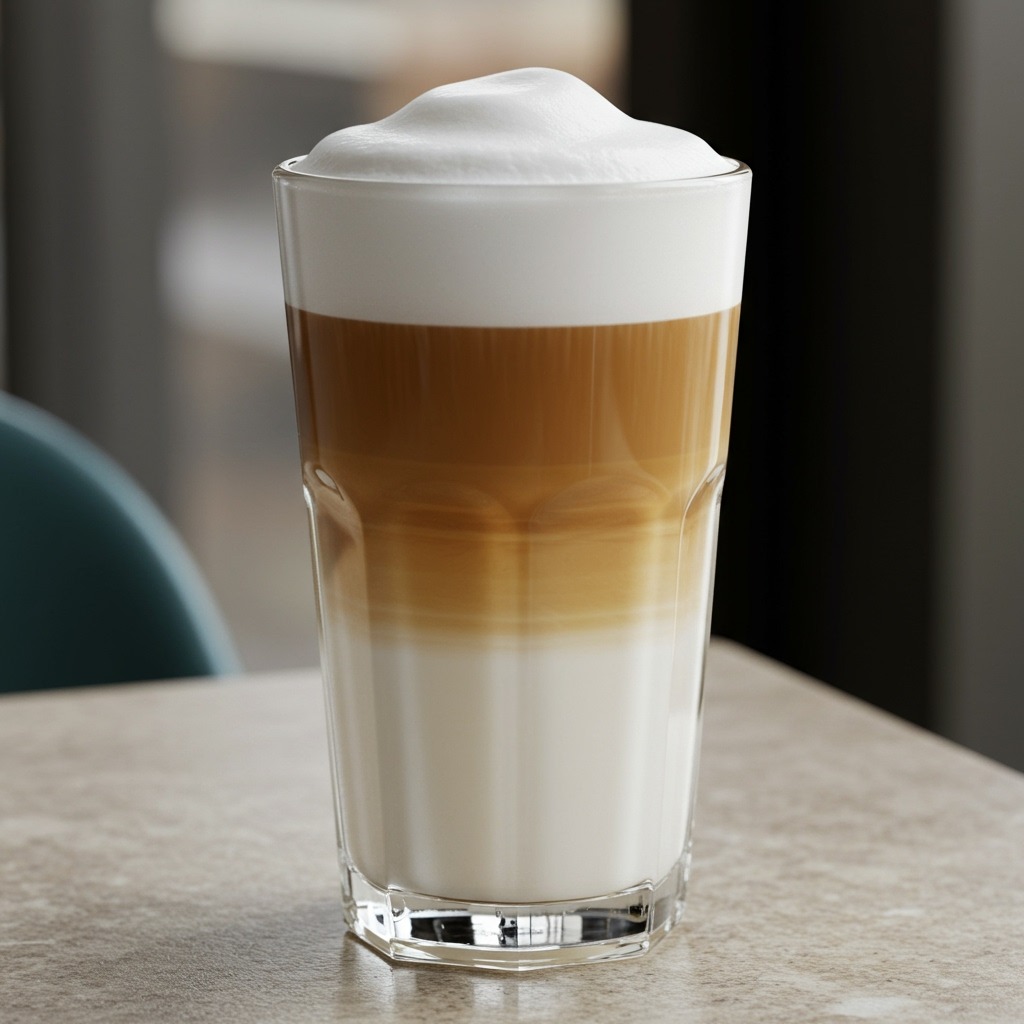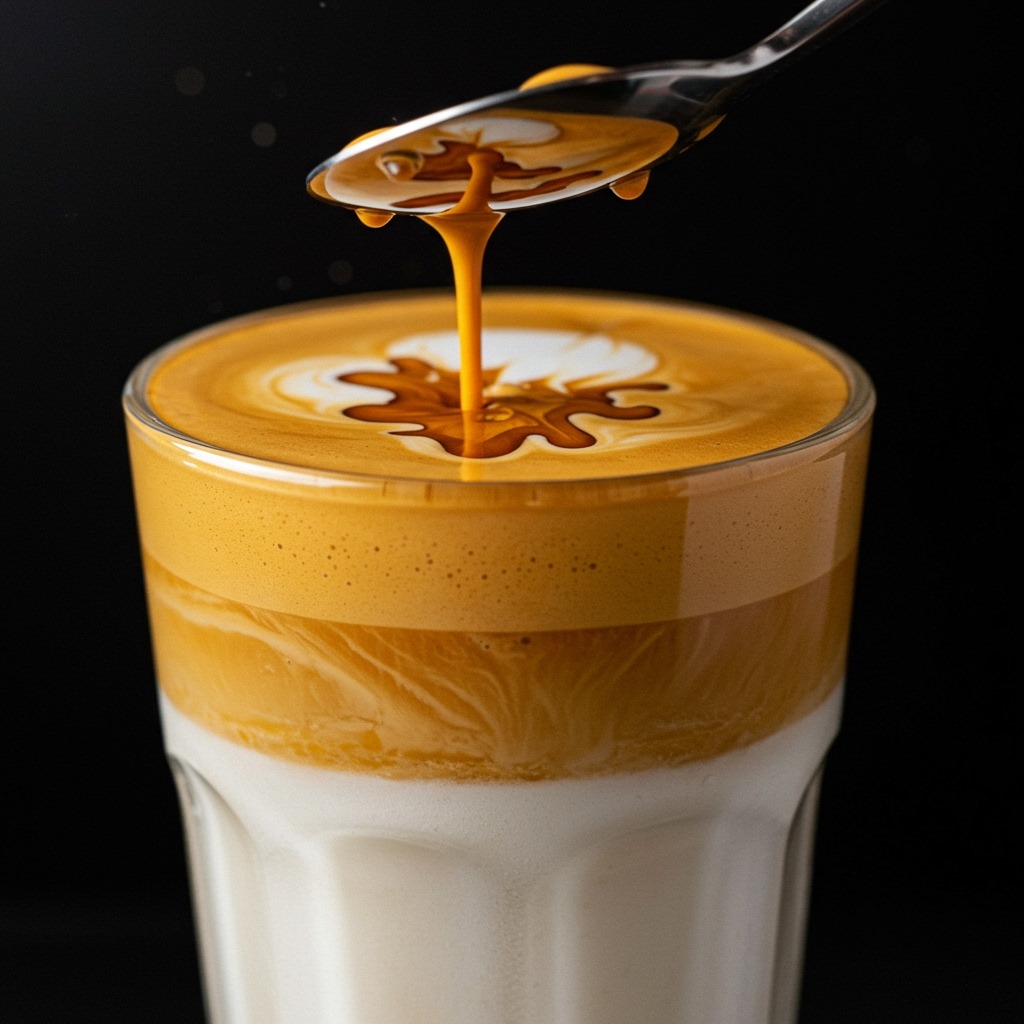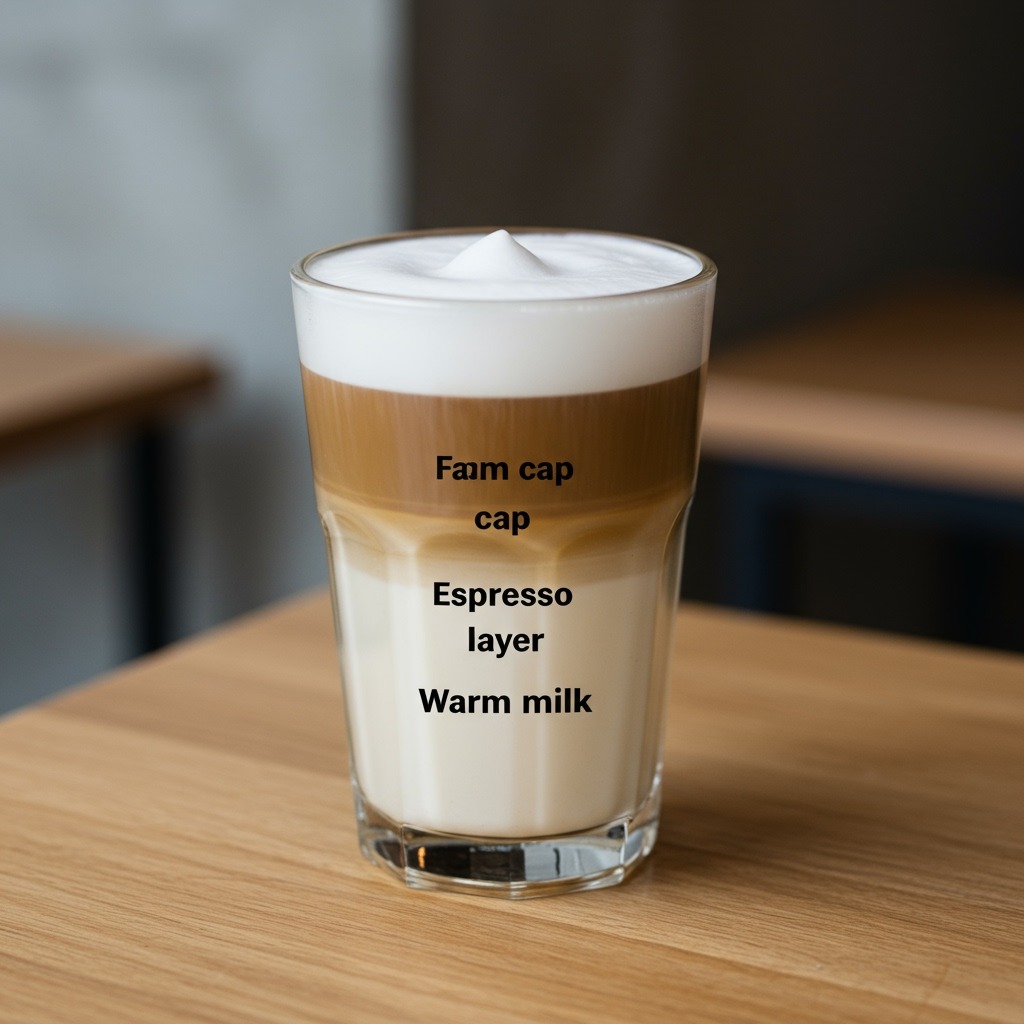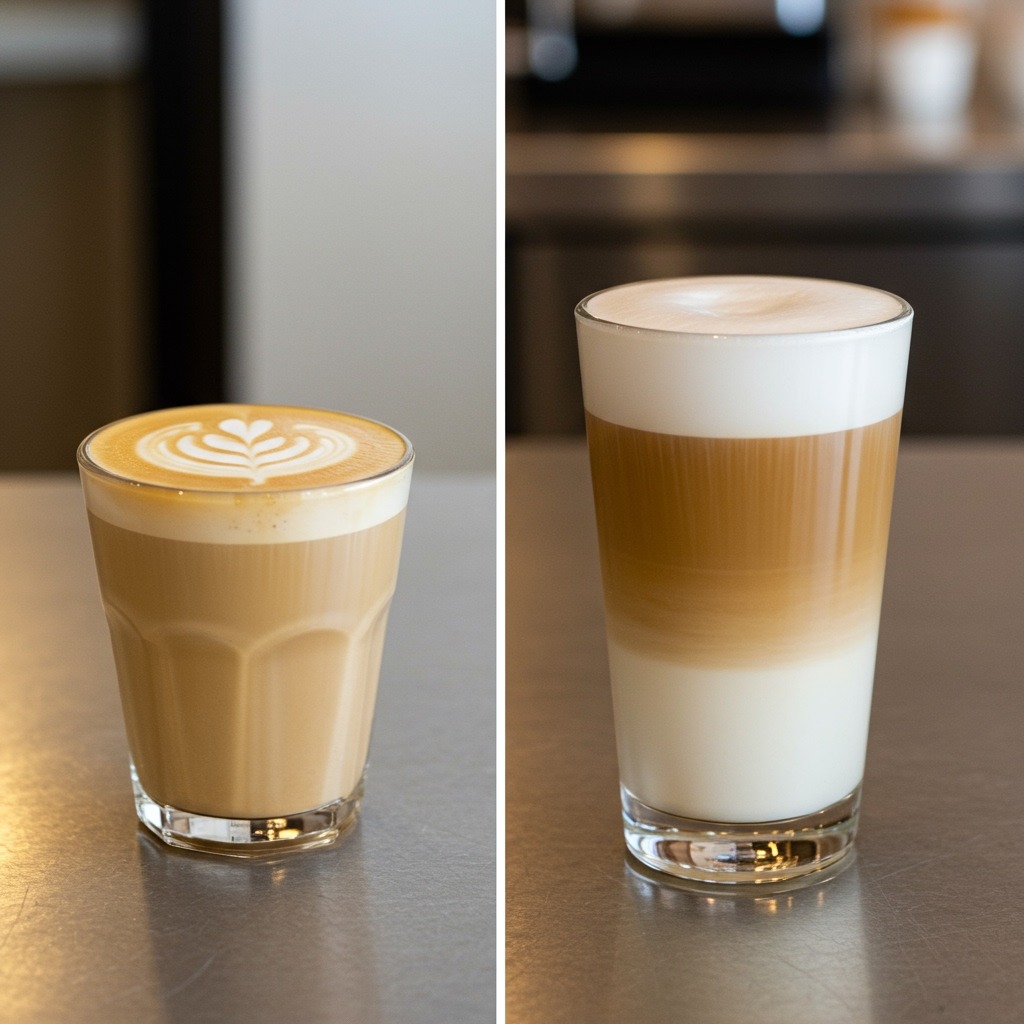Are you tired of confusing coffee shop menus? Do you ever find yourself staring at the board, wondering if a “latte” is the same as a “macchiato,” or perhaps a “latte macchiato” is something else entirely? You’re not alone. The world of coffee can be a delightful maze of terms. But today, we’re cutting through the confusion to illuminate one particularly elegant and often misunderstood beverage: the latte macchiato.
What exactly is a latte macchiato? It’s not just a fancy name; it’s a beautifully layered masterpiece, a symphony of milk and espresso designed for both visual appeal and a distinct flavor experience. While often overshadowed by its more famous cousin, the latte, the latte macchiato stands out with its unique construction and subtly different taste. It’s a drink that coffee aficionados adore for its sophisticated presentation and creamy, gentle coffee notes.

Latte Macchiato Demystified: What Sets It Apart
The core of understanding a latte macchiato lies in its name. In Italian, “macchiato” means “stained” or “marked.” So, a latte macchiato literally translates to “marked milk.” This isn’t just a linguistic detail; it’s the defining characteristic that immediately sets it apart.
The Defining Characteristic: “Stained Milk”
Unlike a regular latte where espresso is added first and then milk, the latte macchiato reverses this order. You start with warm, steamed milk, and then you carefully “stain” or “mark” it with a shot of espresso. This inverted order is key to its signature appearance and flavor profile. It’s a subtle but significant difference that transforms the entire drinking experience. Think of it as a canvas of milk, beautifully marked by the rich, dark espresso.
Layer by Layer: The Unique Structure
A perfectly made latte macchiato is a visual treat. When served in a tall glass, you’ll clearly see three distinct layers:
- Warm, Foamy Milk (Top Layer): This is the light, airy foam that forms the crown of your drink. It’s light and delicate, providing a soft entry point for your sips.
- A Distinct Shot of Espresso “Marked” on Top (Middle Layer): This is the heart of the drink, the concentrated coffee that is carefully poured into the milk, creating a distinct, dark ring. This “mark” is where the name comes from.
- Liquid Milk at the Bottom (Base Layer): The bulk of the drink is warm, velvety milk, providing a comforting and creamy foundation. This layering isn’t just for show; it influences how you experience each sip, offering varying textures and intensities.
Taste Profile: Creamy, Subtle Espresso
Because you’re pouring espresso into a larger volume of milk, the latte macchiato offers a creamier, milder coffee flavor compared to a traditional latte or cappuccino. The espresso’s intensity is gently diffused by the milk, resulting in a smooth, mellow drink that’s perfect for those who prefer a less coffee-forward taste. You’ll get hints of the rich espresso, but it’s beautifully softened by the warmth and sweetness of the milk. It’s a harmonious balance, allowing the subtle nuances of the espresso to shine through without being overpowering.

Latte vs. Latte Macchiato: The Crucial Differences
This is where the confusion often lies. While both a latte and a latte macchiato involve espresso and milk, their preparation order and resulting characteristics are fundamentally different. Understanding these distinctions is crucial for ordering exactly what you want.
Order of Ingredients: Milk First vs. Espresso First
- Latte: Traditionally, you pull your espresso shot into the cup first. Then, you pour the steamed milk over the espresso, allowing them to fully integrate.
- Latte Macchiato: The sequence is reversed. You pour the steamed milk (including the foam) into a tall glass first. Then, you gently pour the espresso shot into the milk, letting it “mark” the foam and settle into a distinct layer. This inverted order is the single most important differentiator.
Ratio of Milk to Espresso: More Milk, Less Prominent Coffee
While both drinks are milk-heavy, the latte macchiato typically features an even higher proportion of milk to espresso. This results in a much milder coffee flavor. If you find a regular latte a bit too strong, the macchiato might be your perfect match. The emphasis here is on the creamy milk, subtly infused with coffee, rather than the coffee being the dominant taste.
Appearance: Distinct Layers vs. Integrated Blend
This is the most obvious visual cue.
- Latte: Due to the pouring order, the espresso and milk mix, resulting in a homogenous, evenly colored beverage with a thin layer of foam on top.
- Latte Macchiato: Its hallmark is the distinct, beautiful layering—a base of milk, a middle band of espresso, and a cap of foam. When you hold a latte macchiato up to the light, you can clearly see these separate strata. This visual appeal is a big part of its charm.
Milk Foam: Macchiato’s Distinct Foam Layer
A good latte macchiato uses a significant amount of light, airy foam, which helps create that distinct top layer. The espresso is gently poured through it. In contrast, a traditional latte has a thinner layer of microfoam, which is integrated into the drink. For more details on other popular milk-based coffee drinks, you can learn about what is a latte coffee and its characteristics.
Flavor Impact: Milder Coffee Flavor in Macchiato
Due to the higher milk content and the method of preparation, the latte macchiato has a softer, more mellow coffee flavor. The espresso is suspended in the milk, creating a less intense coffee hit upfront. If you prefer your coffee incredibly creamy and subtle, this is your drink. Conversely, a regular latte will have a more pronounced espresso taste.
How to Craft Your Own Latte Macchiato at Home
Ready to impress your friends or simply enjoy a perfect latte macchiato without leaving your kitchen? It’s easier than you think, especially if you have the right tools.
Essential Ingredients
- High-Quality Espresso: This is non-negotiable. Your espresso is the heart of the drink. Use freshly ground beans, preferably a dark roast for a robust flavor that can stand up to the milk. If you don’t have an espresso machine, a strong, concentrated drip coffee or Moka pot coffee can work in a pinch, though the crema won’t be the same. Understanding the difference between espresso and coffee is key here.
- Fresh, Cold Milk: Whole milk is typically recommended for the best foam and creamiest texture due to its fat content. However, alternative milks like oat milk or almond milk can also produce good foam if prepared correctly. Always use cold milk to ensure proper steaming.
Tools You’ll Need
- Espresso Machine: For authentic espresso.
- Milk Frother/Steamer: If your espresso machine doesn’t have one, a handheld frother or even a French press can work.
- Tall Glass: Crucial for showcasing those beautiful layers. A clear glass mug or a large tumbler works perfectly.
Step-by-Step Instructions
- Steam Your Milk: Pour cold milk into your frothing pitcher. Steam the milk to about 150-160°F (65-70°C). You want a smooth, velvety microfoam with a good amount of volume, but not overly stiff. Aim for a texture like wet paint.
- Pour Milk into a Tall Glass: Carefully pour the steamed milk into your tall glass. As you pour, use a spoon to hold back the foamy top layer initially, allowing the liquid milk to settle at the bottom. Once most of the liquid milk is in, scoop the remaining foam on top. This creates your distinct bottom milk layer and a fluffy top layer.
- Pull Your Espresso Shot: While your milk is settling, pull a fresh shot (or two, depending on desired strength and glass size) of espresso. Ensure it’s hot and fresh.
- “Mark” the Milk: This is the magic moment. Hold your espresso shot about 4-6 inches above the glass. Slowly and steadily, pour the espresso through the foam and into the milk. The density difference will cause the espresso to settle between the liquid milk and the foam, creating that iconic “mark.”
Tips for Perfect Layers
- Pour Slowly and Gently: Rushing the espresso pour will cause it to mix too much with the milk, losing the distinct layers.
- Use a Spoon: As mentioned, use a spoon to hold back the initial foam when pouring the milk, then spoon it on top. This helps create the bottom liquid milk layer.
- Practice Makes Perfect: Don’t get discouraged if your first attempt isn’t perfectly layered. Like any coffee art, it takes practice.

Enjoying Your Latte Macchiato: Variations & Pairings
Your homemade latte macchiato is ready. Now, how to enjoy it?
Sweeteners and Flavorings
- Syrups: Add a pump of vanilla, caramel, hazelnut, or even a seasonal syrup like pumpkin spice. These can be added to the milk before steaming or directly into the finished drink.
- Cocoa/Cinnamon: A dusting of cocoa powder or cinnamon on top of the foam adds a delightful aroma and subtle flavor.
Alternative Milks
While whole milk creates the best foam, you can absolutely experiment with dairy-free options. Oat milk is a popular choice for its creamy texture and ability to froth well. Almond and soy milk also work, though they might yield a slightly thinner foam.
Ideal Serving Temperature
A latte macchiato is meant to be enjoyed warm, not scalding hot. The ideal temperature allows you to appreciate the layers and flavors without burning your tongue.
Pairings
This creamy, mellow drink pairs wonderfully with light pastries, croissants, or even a simple piece of toast. It’s a comforting morning beverage or a perfect afternoon pick-me-up. You might even find it a delightful companion to a rich, dark chocolate.
Latte Macchiato vs. Other Espresso Drinks
To truly appreciate the latte macchiato, let’s briefly compare it to a couple of other popular espresso and milk combinations.
Latte Macchiato vs. Cappuccino
- Cappuccino: Traditionally, a cappuccino aims for equal thirds: one-third espresso, one-third steamed milk, and one-third milk foam. The milk and espresso are mixed, forming a more integrated flavor.
- Latte Macchiato: Features a much higher milk-to-espresso ratio and distinct layers, with the espresso “marking” the milk, not being the primary base. Its flavor is much creamier and less coffee-forward than a cappuccino.
Latte Macchiato vs. Flat White
- Flat White: Known for its velvety microfoam that’s fully integrated into the espresso, creating a smooth, strong coffee flavor with a thin, latte-art-friendly top. There are no distinct layers.
- Latte Macchiato: In contrast, the latte macchiato emphasizes distinct layers and a substantial foam cap, with a milder coffee presence due to the milk-first pouring order.
Latte Macchiato vs. Cortado
- Cortado: A much smaller drink, typically equal parts espresso and steamed milk, with very little foam. It’s designed to “cut” the acidity of the espresso. For a deeper dive, explore what is a cortado coffee in detail.
- Latte Macchiato: A larger, milkier drink with prominent layers and a softer espresso flavor.
Each of these drinks offers a unique experience, showing the incredible versatility of espresso and milk combinations. Understanding the differences empowers you to choose the perfect coffee for your mood and preferences.

FAQ Section
Q: What does “macchiato” mean in coffee terms?
A: “Macchiato” is an Italian word meaning “stained” or “marked.” In coffee, it refers to an espresso that is “marked” with a dollop of foamed milk (as in an Espresso Macchiato) or, in the case of a latte macchiato, milk that is “marked” with espresso.
Q: Is a latte macchiato stronger than a regular latte?
A: No, generally a latte macchiato is milder than a regular latte in terms of coffee flavor. This is because the espresso is poured into a larger volume of milk, diffusing its intensity more, and the milk-first pouring order often means the espresso is less integrated, offering a creamier, less coffee-forward taste profile.
Q: Can I make a latte macchiato without an espresso machine?
A: While an espresso machine provides the best result, you can make a decent approximation using very strong, concentrated coffee from a Moka pot or AeroPress. You’ll also need a separate method for frothing milk, such as a handheld frother, a French press, or even shaking warm milk vigorously in a jar.
Q: What kind of milk is best for a latte macchiato?
A: Whole milk is traditionally recommended for its higher fat content, which produces the richest and most stable foam. However, oat milk is an excellent dairy-free alternative that froths exceptionally well and adds a creamy texture. Skim milk can also foam, but the texture might be thinner.
Q: What’s the best way to clean my milk frother?
A: Immediately after use, wipe down your frothing wand with a damp cloth to prevent milk from drying and hardening. For thorough cleaning, detach parts if possible and wash with warm, soapy water. Run water through the steam wand briefly to clear any internal milk residue. For more general cleaning advice, learning how to clean a coffee maker thoroughly can help maintain all your coffee equipment.
The latte macchiato is more than just a drink; it’s an experience in layers, texture, and subtle flavor. With this guide, you now have the knowledge and tools to appreciate its nuances and even craft your own perfect version at home. So, next time you’re at your favorite coffee shop, or standing in your kitchen, you can confidently order or prepare this elegant beverage, truly savoring every marked, creamy sip. Enjoy your coffee journey!
